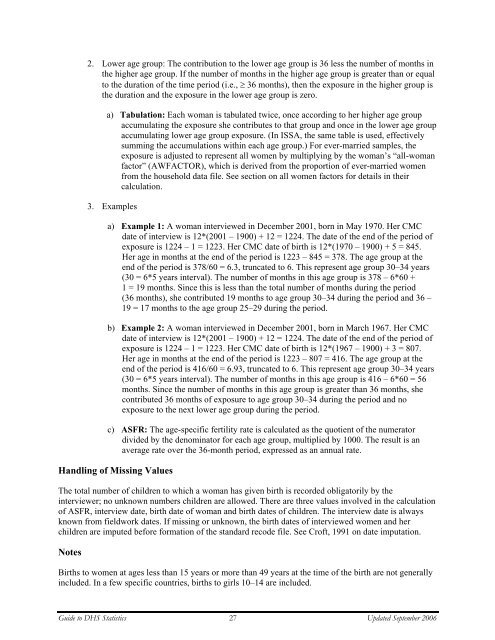Demographic and Health Surveys Methodology - Measure DHS
Demographic and Health Surveys Methodology - Measure DHS
Demographic and Health Surveys Methodology - Measure DHS
Create successful ePaper yourself
Turn your PDF publications into a flip-book with our unique Google optimized e-Paper software.
2. Lower age group: The contribution to the lower age group is 36 less the number of months inthe higher age group. If the number of months in the higher age group is greater than or equalto the duration of the time period (i.e., 36 months), then the exposure in the higher group isthe duration <strong>and</strong> the exposure in the lower age group is zero.a) Tabulation: Each woman is tabulated twice, once according to her higher age groupaccumulating the exposure she contributes to that group <strong>and</strong> once in the lower age groupaccumulating lower age group exposure. (In ISSA, the same table is used, effectivelysumming the accumulations within each age group.) For ever-married samples, theexposure is adjusted to represent all women by multiplying by the woman’s “all-womanfactor” (AWFACTOR), which is derived from the proportion of ever-married womenfrom the household data file. See section on all women factors for details in theircalculation.3. Examplesa) Example 1: A woman interviewed in December 2001, born in May 1970. Her CMCdate of interview is 12*(2001 – 1900) + 12 = 1224. The date of the end of the period ofexposure is 1224 – 1 = 1223. Her CMC date of birth is 12*(1970 – 1900) + 5 = 845.Her age in months at the end of the period is 1223 – 845 = 378. The age group at theend of the period is 378/60 = 6.3, truncated to 6. This represent age group 30–34 years(30 = 6*5 years interval). The number of months in this age group is 378 – 6*60 +1 = 19 months. Since this is less than the total number of months during the period(36 months), she contributed 19 months to age group 30–34 during the period <strong>and</strong> 36 –19 = 17 months to the age group 25–29 during the period.b) Example 2: A woman interviewed in December 2001, born in March 1967. Her CMCdate of interview is 12*(2001 – 1900) + 12 = 1224. The date of the end of the period ofexposure is 1224 – 1 = 1223. Her CMC date of birth is 12*(1967 – 1900) + 3 = 807.Her age in months at the end of the period is 1223 – 807 = 416. The age group at theend of the period is 416/60 = 6.93, truncated to 6. This represent age group 30–34 years(30 = 6*5 years interval). The number of months in this age group is 416 – 6*60 = 56months. Since the number of months in this age group is greater than 36 months, shecontributed 36 months of exposure to age group 30–34 during the period <strong>and</strong> noexposure to the next lower age group during the period.c) ASFR: The age-specific fertility rate is calculated as the quotient of the numeratordivided by the denominator for each age group, multiplied by 1000. The result is anaverage rate over the 36-month period, expressed as an annual rate.H<strong>and</strong>ling of Missing ValuesThe total number of children to which a woman has given birth is recorded obligatorily by theinterviewer; no unknown numbers children are allowed. There are three values involved in the calculationof ASFR, interview date, birth date of woman <strong>and</strong> birth dates of children. The interview date is alwaysknown from fieldwork dates. If missing or unknown, the birth dates of interviewed women <strong>and</strong> herchildren are imputed before formation of the st<strong>and</strong>ard recode file. See Croft, 1991 on date imputation.NotesBirths to women at ages less than 15 years or more than 49 years at the time of the birth are not generallyincluded. In a few specific countries, births to girls 10–14 are included.Guide to <strong>DHS</strong> Statistics 27 Updated September 2006








![Obtaining Informed Consent for HIV Testing [QRS4] - Measure DHS](https://img.yumpu.com/49850117/1/190x245/obtaining-informed-consent-for-hiv-testing-qrs4-measure-dhs.jpg?quality=85)







